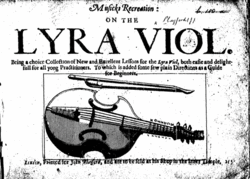This article relies largely or entirely on a single source. (April 2021) |
 | |
| Other names | Leero viol, Leerow viol, Liera viol, Lyro viol[1] |
|---|---|
| Classification | |
| Related instruments | |

The lyra viol is a small bass viol, used primarily in England in the seventeenth century.
Described as "the smallest of the bass viols", one should consider that the consort bass was much larger in 17th century England than most bass viols nowadays (hovering between 78 and 80 cm string length, while the division viol hovers around 76 cm (30 inches according to Christopher Simpson). The lyra viol therefore is the "smallest" and according to James Talbot (end of the 17th century) is therefore 72 cm string length. John Talbot's 17th century measurements for viols Archived 2016-03-22 at the Wayback Machine, The Orthodox viol sizes Archived 2016-03-28 at the Wayback Machine There is a large and important repertoire which was developed specifically for the lyra viol. Due to the number of strings and their rather flat layout, the lyra viol can approximate polyphonic textures, and because of its small size and large range, it is more suited to intricate and quick melodic lines than the larger types of bass viol.
The lyra viol has been favorably compared to both the lute and the violin, by Tobias Hume and Roger North respectively. The name lyra viol came into use because the playing style of bowed chords is similar to that of the lirone.[1]
- ^ a b Frank Traficante. "Lyra viol", Grove Music Online, ed. L. Macy (accessed May 20, 2006), grovemusic.com Archived 2008-05-16 at the Wayback Machine (subscription access).